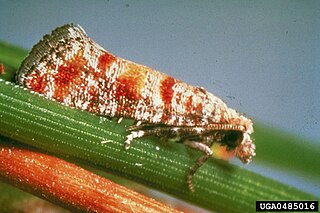
A pine is any conifer tree or shrub in the genus Pinus of the family Pinaceae. Pinus is the sole genus in the subfamily Pinoideae.

The Tortricidae are a family of moths, commonly known as tortrix moths or leafroller moths, in the order Lepidoptera. This large family has over 11,000 species described, and is the sole member of the superfamily Tortricoidea, although the genus Heliocosma is sometimes placed within this superfamily. Many of these are economically important pests. Olethreutidae is a junior synonym. The typical resting posture is with the wings folded back, producing a rather rounded profile.

Rhyacionia buoliana, the pine shoot moth, is a moth of the family Tortricidae. It is native to North Africa, North Asia, and Europe, and invasive in North America and South America.

Rhyacionia is a genus of moths belonging to the subfamily Olethreutinae of the family Tortricidae.

Rhyacionia duplana, the summer shoot moth or Elgin shoot moth when referring to subspecies logaea, is a moth of the family Tortricidae. It is found from northern and central Europe to eastern Russia, China and Japan. It has also been reported from Korea, but it has not been found in recent studies.

Rhyacionia pinicolana is a moth of the family Tortricidae. It is found from northern and central Europe to eastern Russia, China, Japan and Korea.

Rhyacionia pinivorana, the spotted shoot moth, is a moth of the family Tortricidae. It is found from northern and central Europe to eastern Russia, China, Korea and Japan.

The Eucosmini are a tribe of tortrix moths.

Rhyacionia frustrana, the Nantucket pine tip moth, is a moth of the family Tortricidae. It is found in the United States from Massachusetts south to Florida, west to Missouri, Oklahoma, Texas and California. It is also found in the Dominican Republic, Cuba, Jamaica, Mexico (Oaxaca), Guatemala, Honduras and Nicaragua.

Rhyacionia adana, the Adana tip moth, is a moth of the family Tortricidae. It is found in north-eastern North America, including Massachusetts, Pennsylvania, Virginia, Michigan, Wisconsin and Ontario.

Pandemis corylana, the chequered fruit-tree tortrix, hazel tortrix moth, filbert tortricid or barred fruit tree moth, is a moth of the family Tortricidae. It is found from northern and central Europe to Siberia, Korea and Japan.

Rhyacionia bushnelli, the western pine tip moth, is a moth of the family Tortricidae. It is found in the United States, including Alabama, Nebraska, North Dakota and Montana.

Rhyacionia hafneri is a species of moth of the family Tortricidae. It is found in the Czech Republic, Hungary, Croatia, Bulgaria and Slovenia.
Rhyacionia dolichotubula is a species of moth of the family Tortricidae. It is found in Yunnan, China.
Rhyacionia dativa is a species of moth of the family Tortricidae. It is found in China, Taiwan, Korea, Japan and Russia.
Rhyacionia washiyai is a species of moth of the family Tortricidae. It is found in Japan on the island of Hokkaido.
Rhyacionia insulariana is a species of moth of the family Tortricidae. It is found in China.
Rhyacionia leptotubula is a species of moth of the family Tortricidae. It is found in Heilongjiang and Yunnan in China.

Rhyacionia logaea, the Elgin shoot moth, is a species of moth belonging to the family Tortricidae. It was previously considered a subspecies of Rhyacionia duplana, the summer shoot moth. It is now considered the sister species of R. duplana.













